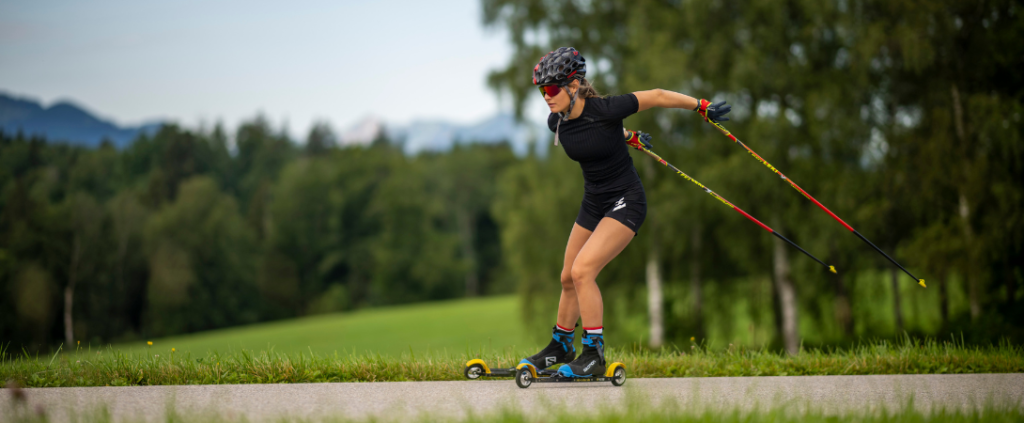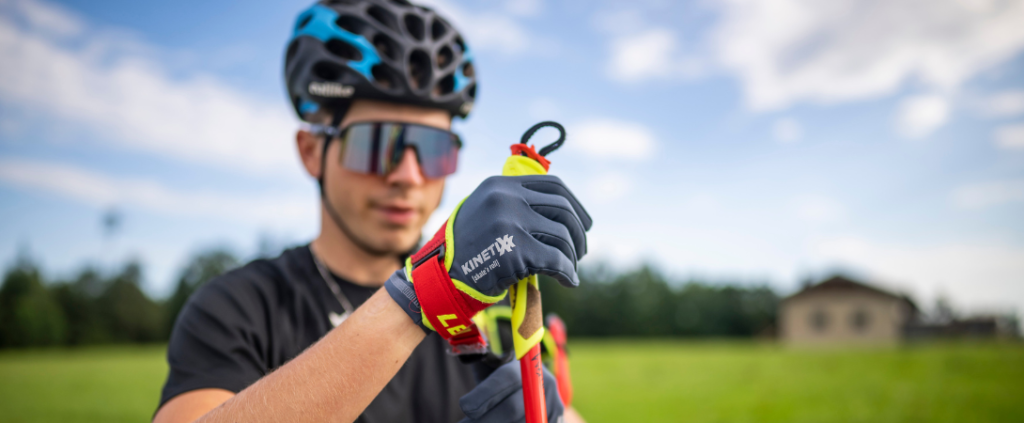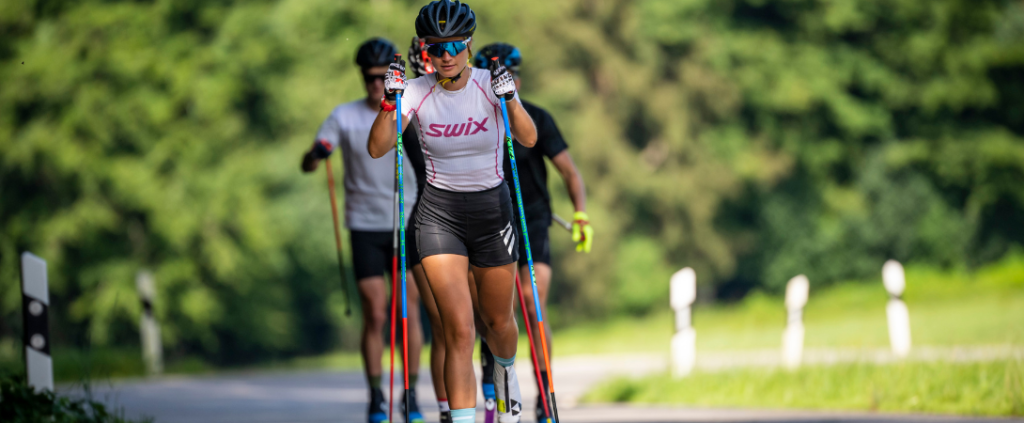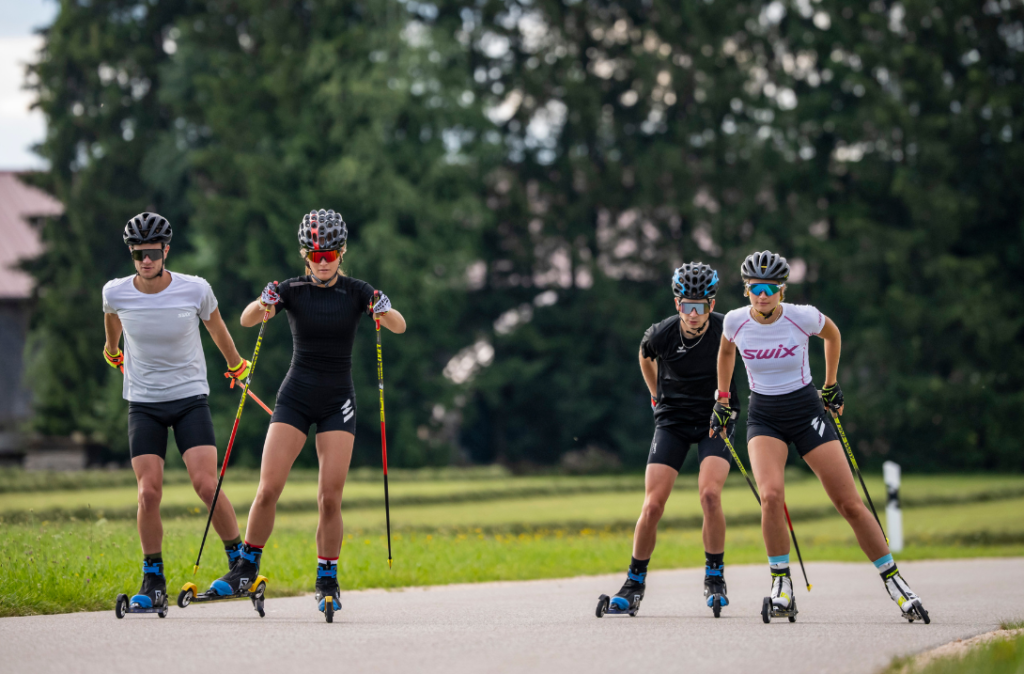Winter sports athletes who use cross-country skis in the snow train their strength and endurance with the roller ski in the summer, and the trend is also catching on with more and more recreational athletes. Training on roller skis is not only very similar to the movement on cross-country skis, it also provides a significantly different training stimulus than cycling or jogging. With the push-off behavior, it strongly resembles the movement sequence of cross-country skiing and thus cross-country skiing techniques can also be refined in summer. Ideally, areas, stadiums, or roller rinks that have been specially closed off for roller training should be used. In public areas, of course, the established bike paths must be used. In many areas, official scooter routes are posted with the appropriate signs. In addition, "light signals" on the helmet or hydration bag are helpful in order to be clearly visible to other road users.

The different running techniques
In general, there are two different techniques and the matching roller ski, once for the free, skating - technique and the other classic - technique. Here, the roller skis, the poles and also the corresponding pole use and the execution of the movement differ.
The skating technique
When skating on ski rollers, the lateral leg push-off occurs explosively from the inside edge, just as in cross-country skiing on the track. The legs then glide alternately to the left and right flat across the ground. The body's center of gravity is always above the gliding leg and shifts to the left and right with the movement.
also with Using the pole there are different techniques
The 2:1 Technik is very popular in this case, in order to make fast progress on levels and inclines. The pole is used here with every second leg push-off. The tips of the poles are placed at the height of the binding of the roller ski and the arms are then actively swung backwards. This is how the power is transferred via the pole to the road and the push-off to the front, of course always in conjunction with the skate movement of the legs. Then the arms swing forward again.
The 1:1 Technik the use of the pole requires a high degree of balance and good strength endurance, which is why it should only be used by experienced runners. Here, the stick is used with every leg push-off. This technique is mainly used for sprinting and accelerating on flat tracks. The poles are placed a little further forward. The sequence remains the same, but the frequency is of course significantly higher.
With the Skate step the drive is mainly from the legs, followed by a long gliding phase. This technique is only used at high speeds mostly also on sloping terrain.

Mit dem Laden des Videos akzeptieren Sie die Datenschutzerklärung von YouTube.
Mehr erfahren
The classic technique
In the classic way of running, a different roller ski is used, this blocks the backward rolling with a return brake, such as the skins in cross-country skiing. With the leg takes place by pressure on the roller ski an explosive push off to the front, then comes a sliding phase and the other side pulls after. After the push-off, the leg is stretched and swings out to the rear. Due to the backstop, a forward movement can take place.
The Using the pole occurs in classic rolling in a diagonal step at the end of the glide phase. The stick touches down near the binding and pushes forward explosively. The arms swing back, the hands let go of the handle of the stick as it swings back, in the forward movement the handle is clasped again. This technique is good for moving forward on the flat and uphill. The longer the glide phase, the better the forward movement.
Another way is Double poleThis one requires good balance and coordination, so this technique is mostly used by advanced students. Both legs push off simultaneously side by side and slide forward. The stick is used synchronously with both arms, at the level of the binding. The body's center of gravity is shifted forward, power is transferred from the arms to the poles, and a forward movement takes place. The upper body goes forward, the knees are bent and the handles of the poles leave the hand. Then the upper body stretches again, the arms swing forward and the hands grip the stick.
Another technique that requires a lot of balance is the Double pole with another step. Hier erfolgt die Gleitphase dann nur auf einem Bein wie beim Diagonalschritt, der Stockeinsatz erfolgt am Ende der einbeinigen Gleitphase.

Mit dem Laden des Videos akzeptieren Sie die Datenschutzerklärung von YouTube.
Mehr erfahren
The right equipment
Training on roller skis should only be done on clean, paved roads, otherwise falls and injuries can occur quickly. With roller skis without brakes, it can be dangerous especially downhill or in curves, which is why good protective equipment and rolling in safe areas is necessary.
Most important, of course, are the ski rollers, either for classic or skating. Skating rollers allow the lateral push off and are thus tiltable to the side. The classic rollers are inherently more stable and have a backstop. Since the classic technique requires a forward push-off, the classic scooter locks during the backward movement and thus generates propulsion. Both the skating - roller and the classic - roller ski have different settings in speeds, roller widths and roller hardness. In order to train the strength endurance in training, a slower roller is rather used to increase the resistance here. During sprint training, on the mountain or during units in fatigue is gladly taken to a faster model. In addition, a scooter with a soft rubber compound is often used for rough asphalt, this absorbs the unevenness of the surface better.

In addition to the scooters, poles & shoes are necessary as in winter. Mostly the same shoes and bindings are used as in winter. For the poles, there are special summer tips, these have a harder metal tip and are therefore more durable. The classic ski pole, as in winter, is slightly shorter than that used for skating.
Important as protection for the head is a helmet, here usually a bicycle helmet is used and the right roller ski gloves. These are very thin and breathable to keep your hands dry even at higher temperatures. In the palm, a good grip, preferably made of silicone is used, for a perfect grip on the handle of the stick. In this way, the power can be optimally transferred from the arms to the pole and the training is even more effective. It is recommended to choose a long-fingered version to protect the hands from blisters or abrasions, for example, when falling. Beginners should additionally protect themselves with elbow and knee pads. Breathable sportswear is worn when roller skiing, just like when jogging or cycling. Finally, the right sports sunglasses round off the outfit.
The correct braking technique
Especially for beginners it is difficult to control the roller skis properly when going downhill, so it is important to practice braking right at the beginning and only after a sufficient practice period, when the balance on the roller skis has been found, to complete downhill rides. Some newer roller ski models have a built-in brake, and it can also be retrofitted. It is triggered by pushing the leg forward over the calf through a lever that brakes the rear wheel. Ski scooters without brakes are usually braked using the "snow plow" technique. Here, as in the plow on skis, the heels turn outward and a straddling position is assumed. The position can then be released and resumed again and again until the roller ski has been completely braked. Alternatively, one leg can be crossed behind the supporting leg and thus braked, but this requires a high degree of balance and good coordination and is only recommended on gentle slopes. Alternatively, for example, the grass strip can be used quite unconventionally for braking.

Mit dem Laden des Videos akzeptieren Sie die Datenschutzerklärung von YouTube.
Mehr erfahren
Plan training sessions
In order to prepare for the winter in the best possible way, strength, endurance, technique and the feeling for movement can be perfectly trained on ski rollers. In general, technique and sequences can be trained in advance without ski rollers and without additional "disturbing factors" in dry conditions, for example at home in front of the mirror or then outdoors shortly before the session. For this purpose, the individual techniques are practiced step by step in a standing position. Through this exercise, the movement sequence is honed in and the sequence gradually improves during the corresponding unit.
Afterwards, various forms of training are run through. Depending on the terrain, the appropriate technique is chosen, as in winter. The route is divided into appropriate sections, which are then completed with the elaborated technique. For example, a slightly uphill section is chosen, which is then run with full focus on the 2:1 technique short (mountain step). The same then with the other two techniques, 2:1 long & 1:1 (as described in the technique section).
Basically, it is advisable to start in the calm pulse range, so that the movement sequences can be trained, which then automatically memorize better and better. Gradually, this clean technique is tried to take into the higher speeds & loads. Depending on the current training level & goal, a pure upper body workout with a double stick can now also be incorporated.

Finally, a training example of upper body strength:
Short warm up (15min), 3 x 10 minutes double stick - push (terrain can be chosen depending on resistance), in between 5 minutes loose movement, cool down (10min).
Double stick training focuses on the upper body, the same format can be chosen here with leg work only and no stick use so that the legs are the focus and they are trained.
Fotos/Videos: K.Voigt Fotografie


